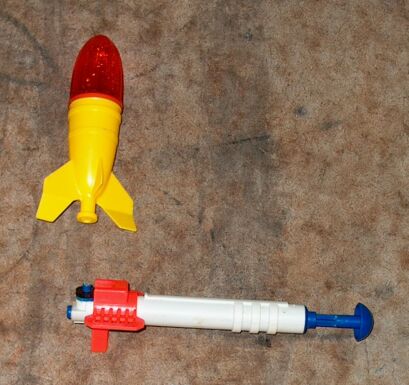
Fill the rocket with water. (The beaker of water and the filling funnel are not shown.) Place the rocket nozzle on the pump head, and secure the lock by sliding it over the nozzle flange. Holding the rocket upright (pump head at the bottom, pointing upwards), pump air into the rocket by operating the pump handle. About a dozen strokes should suffice. Now, still holding the rocket upright, slide back the lock to release the rocket. The rocket flies upward.
This demonstration provides an illustration of Newton’s third law of motion, which states (as quoted in Resnick, Robert and Halliday, David. Physics, Part 1, Third Edition (New York: John Wiley and Sons, 1977), p. 79) To every action there is always opposed an equal reaction; or, the mutual actions of two bodies upon each other are always equal, and directed to contrary parts.
In a rocket, combustion of fuel produces exhaust gases, which exit through engine nozzles. In directing the exhaust gases through the engine nozzles, the rocket exerts a force on them. In turn the exhaust gases exert an equal and opposite force on the rocket, accelerating it upward (assuming that it sits vertically, and that the engine is at the bottom, with its nozzles pointed downward). In this demonstration, the water substitutes for the exhaust gases of a rocket engine, and it is pushed out through the rocket nozzle by the expansion of the air inside the rocket, which you compressed with the pump.
An interesting aspect of the rocket is that because it is propelled by the expulsion of the products of combustion of fuel that is stored within it, as the fuel burns to accelerate the rocket, the mass of the system changes. By Newton’s second law, the external force on an object is equal to its time rate of change of momentum, or Fext = dP/dt. During a time interval Δt, the rocket expels a quantity of exhaust, Δm. At the beginning of that interval, the momentum of the rocket is mv. At the end of the interval, the momentum of the rocket is (m - Δm)(v + Δv). If we take the velocity of the exhaust gases relative to the rocket as vr, then the momentum of the exhaust gases at the end of the interval is Δm(v - vr). The total change in momentum is thus (m - Δm)(v + Δv) + Δm(v - vr) - mv. Multiplying and collecting terms (and dropping the ΔmΔv term, which is negligible) gives ΔP = mΔv - Δmvr. For a rocket near the earth, sitting vertically, this gives mg = mΔv/Δt - vrΔm/Δt, or mΔv/Δt = vrΔm/Δt - mg. If we allow Δt and Δv to approach zero, we have mg = mdv/dt - vrdm/dt. The first term on the right is the net (resultant) force on the rocket. The second term is the thrust – the force that the rocket and the exhaust gases exert on each other. Since this acts in the same line as gravity, we may write this as a scalar equation. We may also rearrange it to give the resultant force as mdv/dt = vrdm/dt - mg. The acceleration of the rocket is dv/dt = (vr/m)dm/dt - g. As the rocket rises farther from the earth, g decreases. When the rocket is no longer near earth, the only force acting on the rocket is the thrust. (Which, of course, acts in the opposite direction on the exhaust gases as they leave the rocket.) Note that as the fuel burns, the mass of the rocket decreases, so its acceleration ((vr/m)dm/dt) increases.
References:
1) Halliday, David and Resnick, Robert. Physics, Part Two, Third Edition (New York: John Wiley and Sons, 1978), pp.174-8.
2) Sears, Francis Weston and Zemansky, Mark W. College Physics (Reading, Massachussetts: Addison-Wesley Publishing Company, Inc., 1960), pp. 167-8.